|
Classic Airframes' 1/48 scale
Dornier Do 17 Z
by Brett Green
|
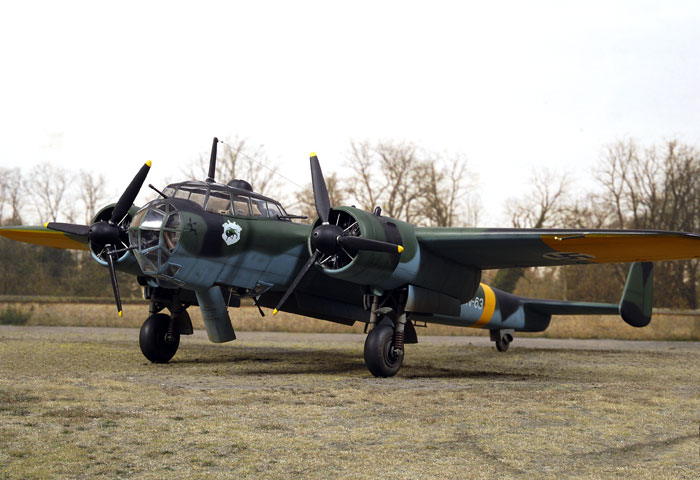 |
|
Dornier Do 17 Z |

Classic Airframes' 1/48 scale Dornier Do 17 Z is available
online from
Squadron
Background
The Dornier Do 17 was the first truly modern medium
bomber to see service with the Luftwaffe. Its sleek fuselage design led
to it being nicknamed the "Flying Pencil". During the 1930s, early
versions played an essential role in developing tactics, especially over
the skies of Spain with Legion Condor.
The Dornier Do 17 was limited in its range and bomb
load, but it represented the backbone of the Kampfflieger (the German
bomber force) at the outbreak of the Second World War. Even with the
introduction of superior types such as the Heinkel He 111 and with the
Junkers Ju 88 on the horizon, the Dornier Do 17 remained a
numerical important element of the Luftwaffe's bombing campaigns for the
first year of the war.

The extreme vulnerability of the Dornier Do 17 was
eventually exposed during the Battle of Britain where the final
production version, the Do 17 Z, was shot down by Spitfires and
Hurricanes in alarming numbers. Attempts to upgrade defensive armament
(up to eight machine guns bristling from the cockpit's transparencies)
were not effective, so the Dornier was relegated to second line,
training, night fighter and photo reconnaissance duties.
In November 1941, Hermann Goering donated 15
Dornier 17 Zs to the hard-pressed Finns. Finland used these aircraft in
front line bomber and reconnaissance roles for the remainder of the war.
A number of Do 17s continued to serve post-war in Finland
Although the Dornier Do 17 is undoubtedly a
keystone of the Luftwaffe, it is not well represented in plastic. In
1/72 scale, we only have the very old Airfix (Do 17 E/F), Monogram,
Lindberg and
Frog (all Do 17 Z) derived kits. Although these kits were quite
respectable at the time of their release in the 1960s, they are hardly
state of the art today.
The Flying Pencil has fared even worse in 1/48
scale. Hobbycraft released a series of Dornier Do 17s in the 1980s.
These kits were very poor in terms of both accuracy and detail. More of
these later.
Hopes were therefore high for an accurate and well
detailed Dornier Do 17 in 1/48 scale.
Classic Airframes has now addressed Luftwaffe
modellers' wishes with the first of their 1/48 scale Dornier Do 17 family - a Do 17
Z in Finnish service.
Classic Airframes' 1/48 scale Dornier Do 17 Z
This brand new Dornier comprises 104 parts in grey
styrene; 19 parts in cream colored resin and 9 clear injection molded
parts. In common with other recent Classic Airframes kits,
plastic parts are presented to a very high standard. Moulding quality is
excellent, this time with a high gloss finish to the surface. There was
a little more flash on my sample than I have seen on other recent
Classic Airframes kits
Resin parts are very nicely detailed. These parts are destined for
the cockpit interior, bomb bay and engines.
The high level of detail in the cockpit is warranted by its
visibility inside the large canopy and nose glazings. Classic Airframes supplies
seats, structural features, radio gear, switch (fuse) panel and bomb
sight in resin; with machine guns, ammunition, bomb sight and shell collection
chutes in injection moulded plastic. One surprise
omission in this area is the throttle / mixture / pitch selector quadrants. In
reality, these would be mostly hidden between the pilot's seat and the
port sidewall, but some modellers may wish to add this feature from
scrap plastic.

The detailed bomb bay is fitted out with a combination
of plastic and resin parts. Two 250kg bombs are included.
The wheel wells are authentically depicted and suitably deep.
Structural rib detail is moulded to the inside surface of the upper
wing, providing a realistic ceiling for both the wheel wells and the bomb
bay.
Clear parts are well moulded and distortion free - very important for
this glasshouse canopy and nose. The parts are slightly cloudy in the
bag, but they positively sparkle after a bath in Future floor polish.
Options include open or closed bomb bay doors and positionable entry
hatch. Control surfaces are moulded in place, with separate actuators
for the elevators.
The shape of the model looks accurate compared to published plans and
contemporary photographs. Classic Airframes has also captured the subtle
aspects of the Flying Pencil that were either poorly represented or
missed altogether by Hobbycraft. Happily, the Classic Airframes fuselage
does not sweep upwards toward the tail (the Hobbycraft fuselage did,
leading to the kit often being referred to as the "Flying Banana"!). CA
has also correctly depicted the forward fuselage side windows (missing
completely on the Hobbycraft kit); the nacelle intakes and exhausts, the
intricate shape of the ventral machine gun position and its recess in
the fuselage, and the undercarriage (the Hobbycraft Do 17 Z featured
gear legs of the early series).

If you have built one of Classic Airframes recent larger kits such as
the Anson or the Canberra, you will have a good idea of what to expect
with this big new Dornier.
The most important step is careful and thorough preparation of the
kit parts prior to assembly, both plastic and resin. I spent around an
hour and a half removing flash from the kit parts and separating resin
pieces from their casting blocks. Care is required with
the delicate undercarriage parts, but the effort is worthwhile as
underlying detail is very good. The backrests of the bombardier's and
radio operator's seats are very delicate too.
When removing the engines from their casting blocks it is important
to retain the resin stem behind the engine cylinders. Try to cut the
engines flush with the casting blocks. The resin stem behind the engine
acts as a post to mount the engine assembly.
Construction commenced in the well-appointed cockpit. My anxiety
about exact positioning of parts was unfounded, as the plastic cockpit
walls have locating lugs to help position the horizontal rails (resin
parts R1 and R2), which then aid in installing the other parts.

Fit was very good in this area, but painting was
trickier than usual as some of the detail is quite deep inside the tub.
I managed though, with the aid of a toothpick!
The interior surfaces were treated to a wash of thinned
Lamp Black and Raw Umber oil paint.
Once dry, I added harness straps from Eduard's 1/48
scale Luftwaffe Bomber Seat Belts set (49 003).
The sidewalls were spruced up with placard decals from
Reheat Models, and instrument dials were sourced from MDC's Luftwaffe
Instruments decal sheet.
The bomb bay was next. The connecting arms of two of the
vertical bomb racks (part 24) were too long. These were simply cut to the same
length as the other six and glued in place.
I applied fairly heavy weathering to the bomb bay,
partly due to the utilitarian nature of this space; and partly because
the dark recesses would completely obscure subtle weathering!
The balance of construction was fast and straightforward.
I assembled the upper and lower wing
parts before offering them to the fuselage. This sequence meant that
the locating tabs on the fuselage wing root interfered with fit, so
I cut them off.
A little trimming and thinning around
the inside of the upper wing root was required to achieve a perfect
fit.
Alignment of the tailplanes was very
good. The only problem was of my own making. I trimmed too much
plastic from the rear fuselage where it meets the front of the
horizontal stabiliser, resulting in a gap which I later filled with
Milliput.

Click
the thumbnails below to view larger images:
[../../photogallery/photo00024109/real.htm]
I glued the bottom of the nose
section to the main fuselage before adding the top of the nose
section. I believe that this is the best way to ensure alignment in
the most critical areas - the nose to fuselage side join, and the
top nose join at the insert in the upper wing.
Once the lower nose, wings and main
fuselage had set, I added the upper nose. I aligned this with the
insert in the upper wing. The compromise was a narrow wedge-shaped
gap between the top and bottom nose halves. This was easily filled
with Milliput once the parts had set, but the result was a flawless
fit between the upper nose and the shoulder of the wing.
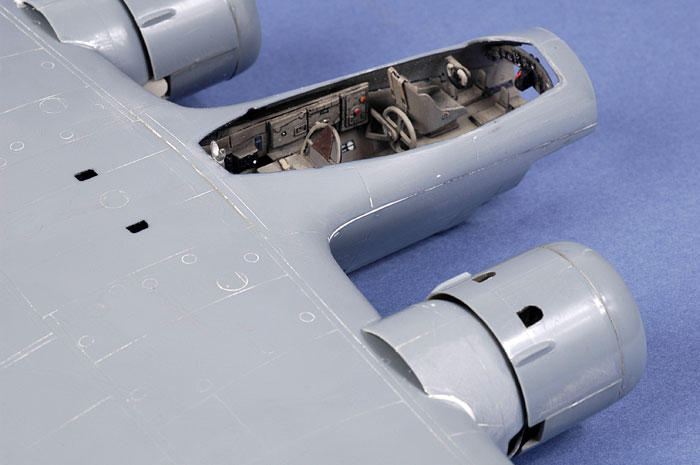
The left and right engine nacelles
are identical, but the leading edge of the wings are slightly swept
back. This results in a small gap on the outboard join between each
engine nacelle and the wing leading edge. Milliput was once again my
weapon of choice to deal with these gaps.
I added the chaotic and very prominent
engine cowl bracing using
lengths of .020 plastic strip super glued to the front and rear of
the engine crank cases. This was easier than I expected, and will
have a big visual impact on the front of the model.
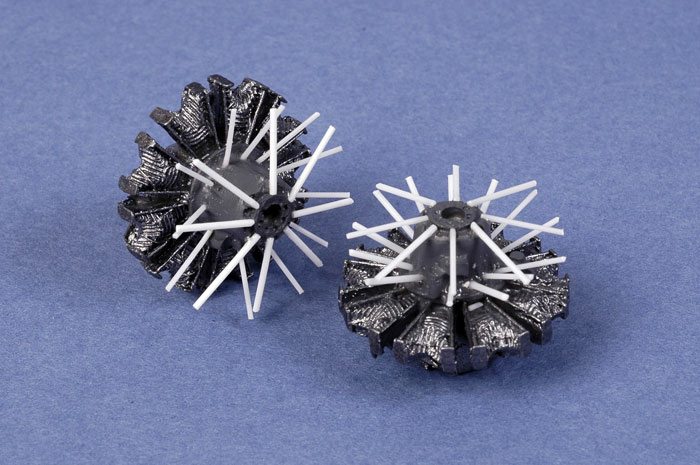
The canopy, nose glazing
and side windows were masked with Tamiya tape. I was dreading this
job, but it was actually quite fast. I cut each panel while the tape was
in place on the window, significantly speeding the task.
With the basic construction
completed, the clear parts were glued to the front of the aircraft.
Before glue was applied, however, the machine gun barrels were cut off
and the main bodies of the guns were glued to the inside of the
appropriate clear parts. I assumed that I would inevitably knock off
some or all of these delicate gun barrels during heavy handling while
painting the model. At least this way I could keep track of all the gun
barrels!
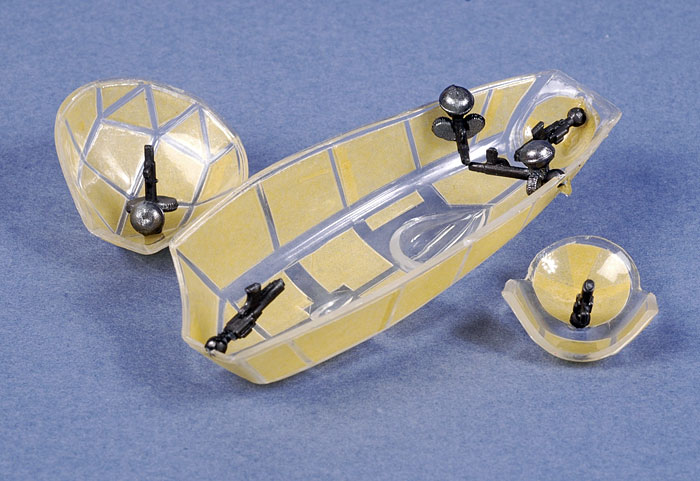
The fit of the starboard side windows and the bomb aimer's bulge was
a little tricky, requiring several rounds of trimming and test fitting,
but the canopy and nose parts were a very good fit. A tiny gap along one
side of the nose cap was filled with Micro Krystal Kleer.
Only a little filler was used on the airframe.
Milliput
was used to smooth a small step at the top wing to fuselage join, and
underneath the trailing edge of the wing root (as well as the
aforementioned tailplane and horizontal nose join).
Painting,
Decals and Weathering
|
Paint
 All
paint was applied with my Testor Aztek A470 airbrush fitted with the
fine tan coloured tip. All
paint was applied with my Testor Aztek A470 airbrush fitted with the
fine tan coloured tip.
First the masked canopy frames were
painted grey.
Next came a coat of white primer on the
rear fuselage and lower wingtips. This was lightly sanded and polished before
spraying a coat of Tamiya Spray TS-34 "Camel Yellow" on the area. I
decanted a quantity of this gloss yellow paint from the can into a
disposable container and applied the paint using my Aztek airbrush. This
acrylic lacquer still needed two coats over the white primer, but it
dried fast and coped well with subsequent handling.
Once thoroughly dry, the yellow
rear fuselage bands and lower wingtip markings were masked using Tamiya masking tape.
At this time, the open bomb bay and wheel wells were stuffed with tissue
to protect them from paint overspray. The small bomb bay observation
windows were also blocked.
The first camouflage colour was my personal blend of Light Blue, applied
to the lower surfaces and fuselage sides. The Finnish Light Blue Grey
seems to be slightly more vibrant than RLM 65, so I mixed Tamiya XF-23
Light Blue with approximately 20% X-14 Sky Blue to obtain a fairly vivid
shade.
Finnish Dark Green seems to be an elusive colour. Different sources will
suggest anything from a hue similar to British Dark Slate Grey to Olive
Drab. I settled on a dark green shade. For this, I used Polly Scale RAAF
Foliage Green, which is similar to US Medium Green.
Black can sometimes look stark and unrealistic on a model, so I mixed
50% XF-1 Flat Black with 50% XF-64 Red Brown for a "scale black" colour.
The camouflage pattern was sprayed freehand (ie, without masks), but in
a tight, semi-hard demarcation to match the finish seen in wartime
photos.
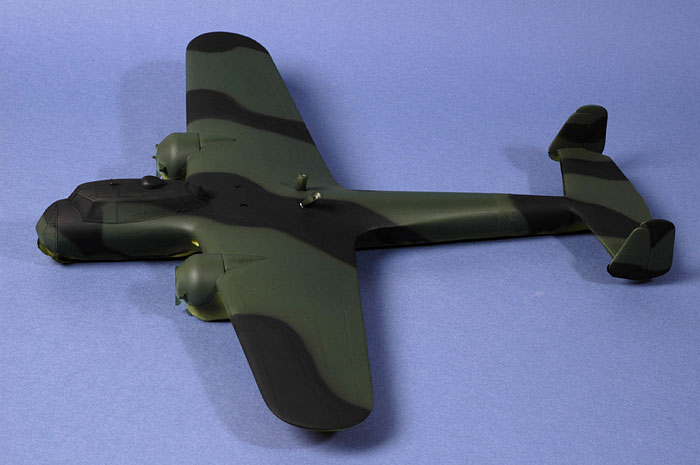
Click the thumbnails below to view larger images:
[../../photogallery/photo00027192/real.htm]
Weathering
Weathering was kept to a minimum as the paintwork on
these hard-working aircraft seemed to be well maintained.
A very thin mix of Tamiya XF-64 Red Brown and XF-1 Flat
Black was sprayed along selected panel lines.
Light streaks and spots were also sprayed onto the larger areas of the
wings and the fuselage to represent subtle staining. In fact, this
effect was so subtle that it virtually disappeared under the flat coat!
Some pale streaks were also added to the light blue
lower nose and wings.
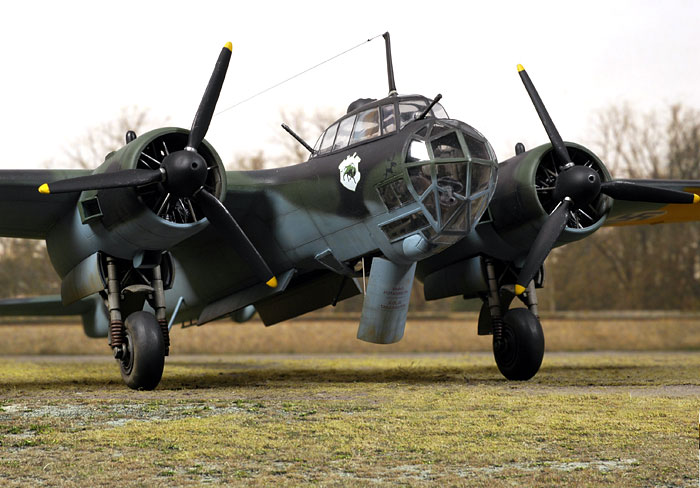
A thin wash of Tamiya Semi-Gloss Black acrylic paint was applied with a
fine brush to selected panel lines.
Tamiya pastel chalks were rubbed onto the lower edges of
the gear doors and the crew entry hatch. They were also applied to the
wheels.
Decals
The model received a coat of Polly
Scale Gloss acrylic before the markings were applied. I find that the
Polly Scale clear finish can be more easily controlled than Future when
spraying, does not run on horizontal surfaces, yet still delivers a
hard, shiny finish ideal for decals.
I used the Classic Airframes kit
decals, which are very thin and
settled down beautifully into panel lines. The only opacity issue that I
encountered was with the lower wing national markings. Although the
white appeared perfectly opaque over the black and dark green of the
upper surfaces, the yellow and light blue were slightly noticeable under
the white of the decals on the bottom of the wings.
The completed paintwork was sealed
with a two thin coats of Polly Scale Flat acrylic.
Once the final flat coat was dry, I
could finally reveal the canopy. Removing the canopy masks felt like
opening a Christmas present. Each new clear panel helped illuminate the
aircraft. The effect of the big greenhouse canopy is very impressive,
and well worth the masking effort.
While removing the masks, one machine
gun came loose from the inside of the canopy and fell into the cockpit.
I initially thought that it would be impossible to refit the gun but,
using a hemostat (long, self-closing tweezers), I managed to insert the
small plastic part through the crew hatch and maneuver it back into
place past obstacles including the floor and radio operator's seat.
Finishing Touches
With the painting and markings out of
the way, the undercarriage could be installed. I was a little concerned
about the fit, but with a little thinning of the attachment points at
the top of the main gear legs, the join was positive and robust.
As final assembly galloped along, I
did not notice that I had dropped one engine nacelle onto the floor. The
first I knew of it was when I heard a sickening "crack" under my heel.
Fortunately the engine was not inside, but the nacelle was broken into
three pieces (not the three it had started out as), and was well out of
round. I repaired and repainted the nacelle with only a few more
outbreaks of drama and bad language.

A number of scratch-built finishing touches were now
applied. These included:
-
the
"clothes rack" aerials on the bottom of the fuselage. The short
posts were metal rod and the horizontal aerials were fine plastic
rod
-
lower
fuselage trailing antenna formed from Contrail aerofoil section
strut and fine copper wire.
-
pitot tube from
bent brass wire.
-
wing
tip lights created by painting small coloured dots on the wing tips,
then covering them with small blobs of two-part epoxy glue
(Araldite). This is the first time I have used this technique, and
it worked out pretty well.
-
bomb
bay observation windows formed by painting a membrane of Krystal
Kleer around the inside edge of each opening. When dry, I brush
painted a coat of Future floor polish over each window.
-
entry
door retraction struts from copper wire.
-
steel
pin added to the antenna mast to strengthen the join with the
canopy.
-
aerial wire from nylon monofilament and resistors
formed using small blobs of Krystal Kleer.
In
reviewing the model photos, I realised that I had not installed the
prominent elevator actuators on the model. I will glue these in place
and take some new photos over the next week.
This is the second Classic Airframes
kit that I have built so far this year, and it will not be my last. In
2006, I built six Classic Airframes kits from my annual tally of
18 models.
So why have I built so many kits from
this limited run manufacturer?
A cynical observer might suggest that
it is because Classic Airframes is a sponsor of HyperScale, but there
are actually several more compelling reasons.
Firstly, I am excited by many of the
subjects that this manufacturer chooses. The Dornier Do 17 Z is a good
example of an important aircraft that has been crying out for an
accurate injection moulded 1/48 scale kit for decades.
I also genuinely enjoy the challenge
of these limited run kits, where planning, concentration and application
of previous experience are required to achieve a good result. These
models do not fight you all the way through construction, but they can
bite you occasionally if you are not paying due attention.
I do appreciate, however, that many
modellers expect that a kit should not require trimming, adjustment,
test fitting and fabrication of smaller detail parts. Classic Airframes
kits will not appeal to this type of modeller. This is not a criticism,
just an acknowledgement that there are different strokes for different
folks.
Classic Airframes' 1/48 scale Dornier
Do 17 Z is accurate, well detailed and will not present too many hurdles
for the experienced modeller. In terms of degree of difficulty, I would
rate it about the same as the Classic Airframes Anson that I built last
year.
Now, let's see if Classic Airframes
decides to release some Dornier Do 17 E/M/P or 215s!
Thanks to Classic Airframes for the
sample.
Photography
The model was photographed in
HyperScale's studio using a Nikon D70 digital SLR. Illumination was via
two studio flash units - one Bowens 250 and a generic 100 flash - on
stands and illuminating from a high 45º angle from each side of the
front of the photography table.
The camera was fitted with a Micro
Nikkor 60mm lens.
ISO was set to 250, and the manual
shooting settings were 1/100 of a second at f.29. The high aperture
ensures good depth of field.
The model was placed on a base of static grass in front of an enlarged
photograph of foliage behind a stone wall. The images were optimized (brightness and contrast)
in Photoshop CS, resized to 700 pixels in width and saved as 75 dpi .jpg
files using Photoshop's "Save for the Web" option.

For the images with the extended grass
foreground, the model photo was merged with a photograph of grass taken
at Bankstown Airport in Sydney's south-western suburbs. The colour and tone of the grass in the airport photo and the
model photo were matched using Photoshop's "Hue and Saturation" tools. The demarcation
between the model static grass and the real grass in the foreground was
merged using the Clone Stamp tool.
Model,
Images & Text Copyright © 2007 by
Brett Green
Page Created 21 June, 2007
Last Updated
24 December, 2007
Back to
HyperScale Main Page |
Home
| What's New |
Features |
Gallery |
Reviews |
Reference |
Forum |